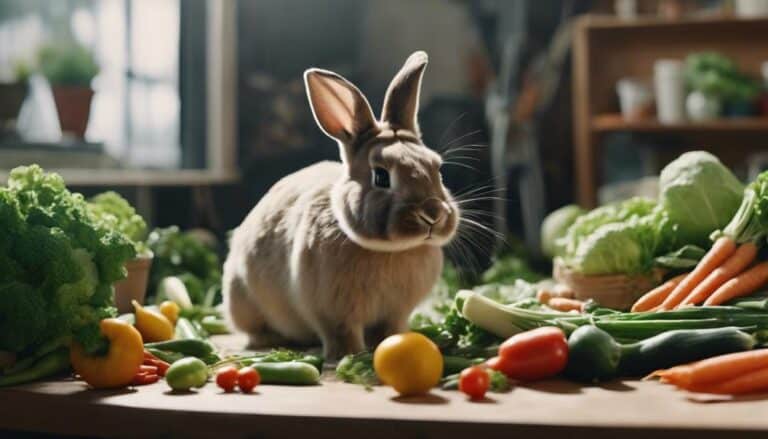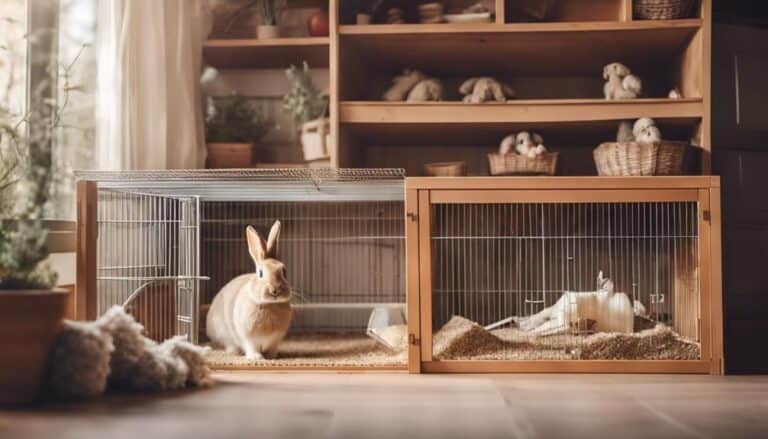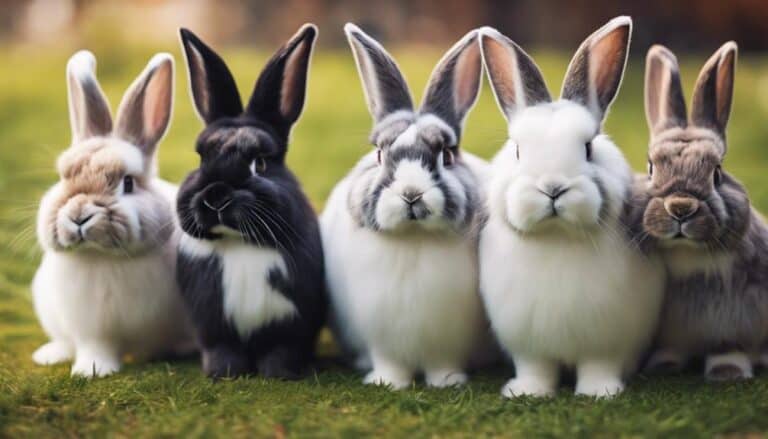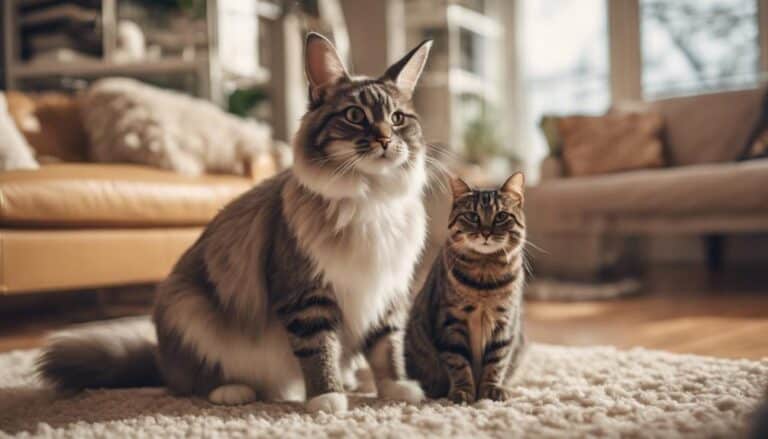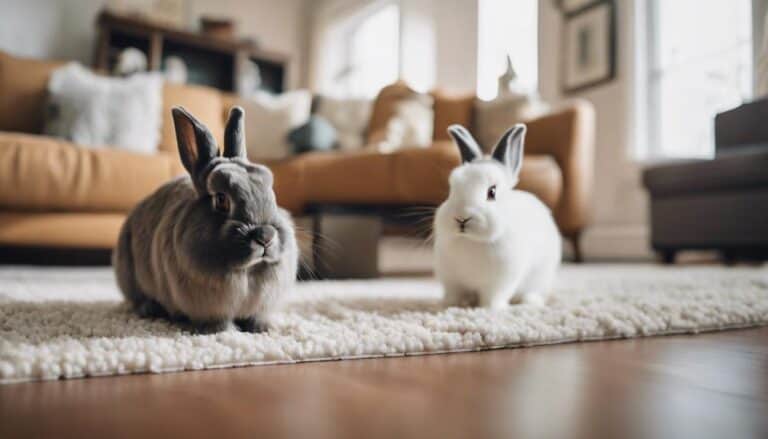Have you ever marveled at a field of wildflowers, each bloom unique in its color and pattern, creating a breathtaking tapestry of nature's artistry?
Similarly, fluffy bunny breeds exhibit a fascinating array of markings that intrigue and captivate observers. These distinct patterns serve more than just an aesthetic purpose; they hold clues to the genetic diversity, selective breeding practices, and environmental influences that shape these adorable creatures.
So, what secrets do these markings hold, and what deeper insights can they reveal about the world of fluffy bunny breeds?
Contents
- 1 Key Takeaways
- 2 Genetic Factors in Bunny Coat Colors
- 3 Influence of Breeding on Markings
- 4 Environmental Impact on Bunny Fur
- 5 Evolutionary Reasons for Unique Patterns
- 6 Symbolism and Cultural Significance
- 7 Practical Benefits of Distinct Markings
- 8 Frequently Asked Questions
- 9 Do Unique Markings on Fluffy Bunny Breeds Affect Their Ability to Get Along with Cats?
- 10 Conclusion
Key Takeaways
- Genetic factors and breeding practices shape the array of unique markings in fluffy bunny breeds.
- Environmental factors influence fur texture and appearance, enhancing the beauty of bunny patterns.
- Symbolism and historical significance contribute to the allure of bunny markings in various cultures.
- Distinct markings aid in genetic tracking, lineage maintenance, and aesthetic appeal in fluffy bunny breeds.
Genetic Factors in Bunny Coat Colors
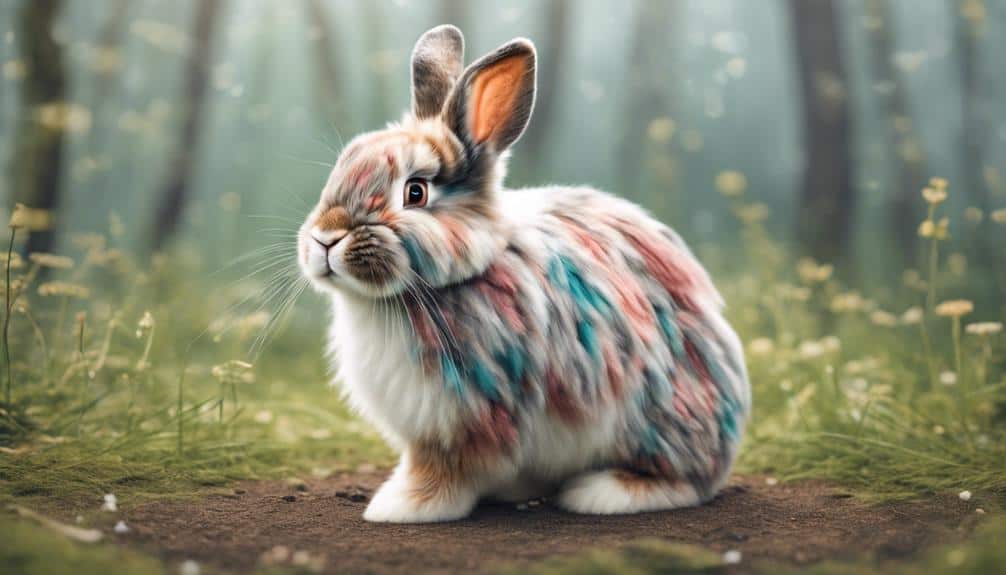
Genetic factors intricately regulate the vibrant array of coat colors and unique markings observed in fluffy bunny breeds. The distinctive checkered patterns and colors in fluffy bunnies are a result of specific genes that control the distribution of pigments in their fur. Eumelanin and pheomelanin, responsible for black/brown and red/yellow pigments, are produced under the influence of various genes. Mutations in these genes can lead to the development of unique markings such as spots, stripes, and color blocks in fluffy bunny breeds.
The presence or absence of particular alleles further contributes to the variations in coat colors and patterns seen in these bunnies, adding to their diversity and individuality. Breeders can utilize this knowledge of the genetic basis of bunny coat colors to predict and selectively breed for specific markings or patterns in fluffy bunny breeds. Understanding how genetic factors influence coat colors is critical for maintaining and enhancing the unique aesthetics of these adorable creatures.
Influence of Breeding on Markings
When breeders selectively pair parent rabbits based on desired markings, they influence the genetic variation within fluffy bunny breeds.
By focusing on specific coat patterns and colors, breeders can create a diverse range of markings in offspring.
The intentional breeding efforts aim to enhance the beauty and individuality of each rabbit through controlled genetic inheritance.
Breeding Impact on Markings
Utilizing strategic breeding practices plays a crucial role in shaping the distinctive markings observed in fluffy bunny breeds.
- Breeders meticulously select rabbits with specific coat patterns to enhance desired traits.
- Through careful breeding techniques, markings in fluffy bunny breeds are refined and amplified over generations.
- Genetic inheritance influences the development of unique markings, with specific genes passed down from parent rabbits.
- Crossbreeding different breeds with distinct markings leads to the creation of new and unique patterns in fluffy bunny breeds.
Genetic Variation in Breeds
The intricate interplay of genetic variations within bunny breeds directly shapes the array of markings present in fluffy bunnies, showcasing the profound impact of breeding practices on these distinctive traits.
Genetic variation, influenced by selective breeding, underpins the diversity of coat patterns observed in fluffy bunny breeds. Through targeted breeding efforts, breeders have honed specific coat patterns, accentuating the unique markings that characterize each breed.
This careful selection has allowed for the preservation and enhancement of desired traits over generations, illustrating the power of genetics in shaping the appearance of fluffy bunnies.
Environmental Impact on Bunny Fur

Environmental conditions greatly impact the growth and quality of fur in fluffy bunny breeds. These factors are important in determining the plush coat and unique markings these bunnies display. Here are four key ways in which the environment influences bunny fur:
- Seasonal Changes: Fluffy bunny breeds adapt their fur thickness and coloration based on seasonal variations. During colder months, the fur may grow denser to provide better insulation, while in warmer seasons, the coat may lighten to prevent overheating.
- Temperature and Humidity: Fluctuations in temperature and humidity levels can affect the texture and appearance of a bunny's fur. High humidity may lead to frizz or matting, while extreme temperatures can impact fur growth and quality.
- Stress and Health: Stress and health issues can cause changes in a bunny's fur texture and appearance, potentially altering their markings or patterns. Maintaining a stress-free environment and good health is essential for preserving the luster of a fluffy bunny's coat.
- Diet and Grooming: Proper nutrition and grooming habits are important for ensuring the health and vibrancy of a bunny's fur. A well-balanced diet and regular grooming routine contribute to the overall appearance of unique markings in fluffy bunny breeds.
Evolutionary Reasons for Unique Patterns
Evolutionarily, the unique patterns found in fluffy bunny breeds are thought to have arisen as adaptive traits serving various functional purposes. For instance, the Holland Lop and English Angora rabbit may have developed distinctive colors to aid in camouflage, allowing them to blend into their natural surroundings and avoid detection by predators. This trait could have provided a survival advantage, increasing the likelihood of these rabbits passing on their genes to future generations.
In addition, these markings may also play a role in communication within social groups. Certain patterns could serve as signals of dominance, helping establish hierarchies and reduce conflicts among individuals. During breeding seasons, striking markings might aid in attracting potential mates, thereby increasing reproductive success.
Additionally, the evolution of unique patterns in fluffy bunny breeds could be linked to genetic mutations that proved advantageous over time. Some rabbits with bold patterns may appear larger or more intimidating, potentially deterring predators. These adaptive traits highlight the intricate relationship between appearance, behavior, and survival in the natural world.
Symbolism and Cultural Significance
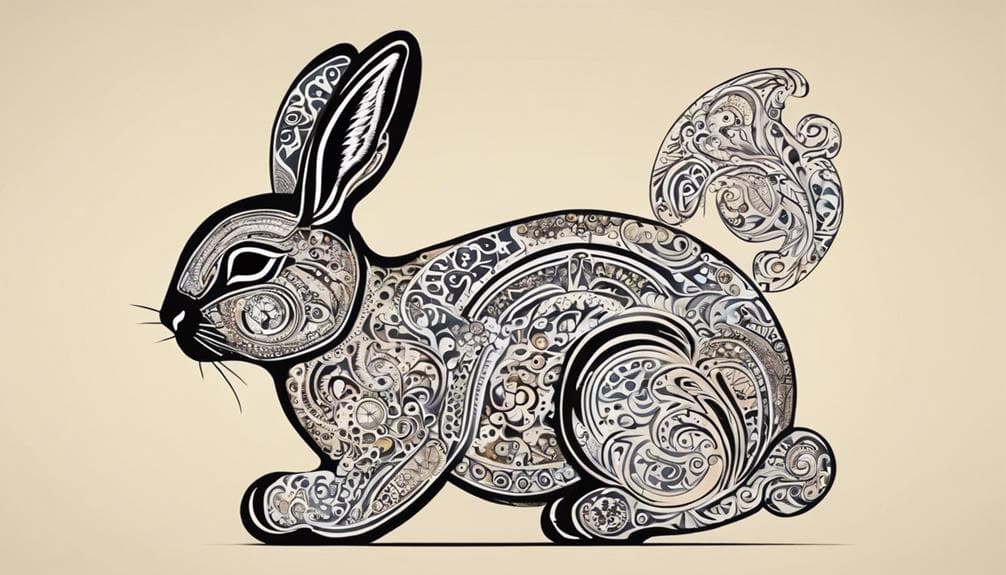
Certain markings on fluffy bunny breeds can hold deep cultural significance, symbolizing various beliefs and traditions across different societies.
Historical connections to symbols and myths often influence the interpretation of these intricate patterns, adding layers of meaning to the visual appeal of these breeds.
Understanding the symbolism and cultural significance behind these unique markings provides valuable insights into the diverse narratives associated with fluffy bunny breeds.
Cultural Beliefs in Markings
Cultural beliefs regarding specific markings on fluffy bunny breeds often attribute symbolic meanings and cultural significance to these distinctive patterns.
- The symmetrical markings of the Dutch Rabbit are often associated with balance and harmony, reflecting values of symmetry in some cultures.
- The unique facial patterns of the English Lop may symbolize good fortune or luck, making them desirable in certain cultural beliefs.
- Patterns like the color blocks on the Harlequin Rabbit can represent ideals of harmony and balance, influencing cultural preferences for certain breeds.
- The appeal of the Dutch Rabbit's bold and symmetrical markings aligns with cultural values of order and symmetry, contributing to its popularity in regions where such traits are highly regarded.
Historical Connections to Symbols
Studying the historical origins of the unique markings found on fluffy bunny breeds offers valuable insights into the symbolic connections and cultural significance embedded within these distinct patterns.
The luxurious coat of these bunnies, adorned with specific markings, often reflects a blend of historical influences that have shaped their appearance over time.
In competitive shows, these markings play an important role in distinguishing one breed from another, showcasing the diversity of cultural significance tied to each.
Through the lens of history, one can trace back the evolution of these patterns to ancient times, where they symbolized different virtues, beliefs, or affiliations within various societies.
Understanding the historical connections to symbols in fluffy bunny breeds reveals a rich tapestry of meanings that contribute to their allure and mystique.
Interpretation of Bunny Patterns
Exploring the intricate patterns adorning fluffy bunny breeds exposes a world of symbolism and cultural significance intertwined within their unique markings.
- Flemish Giants are known for their distinctive coat patterns, with some cultures believing that specific markings on these bunnies bring good luck and prosperity.
- Rex rabbits, famous for their velvety fur, often display patterns that symbolize protection and safety in certain societies.
- Cheek spots, commonly found on various bunny breeds, are thought to represent fertility and abundance in many cultural traditions.
- Interpretations of bunny patterns can vary greatly, with some communities attributing spiritual meanings to specific markings on these beloved animals.
Practical Benefits of Distinct Markings
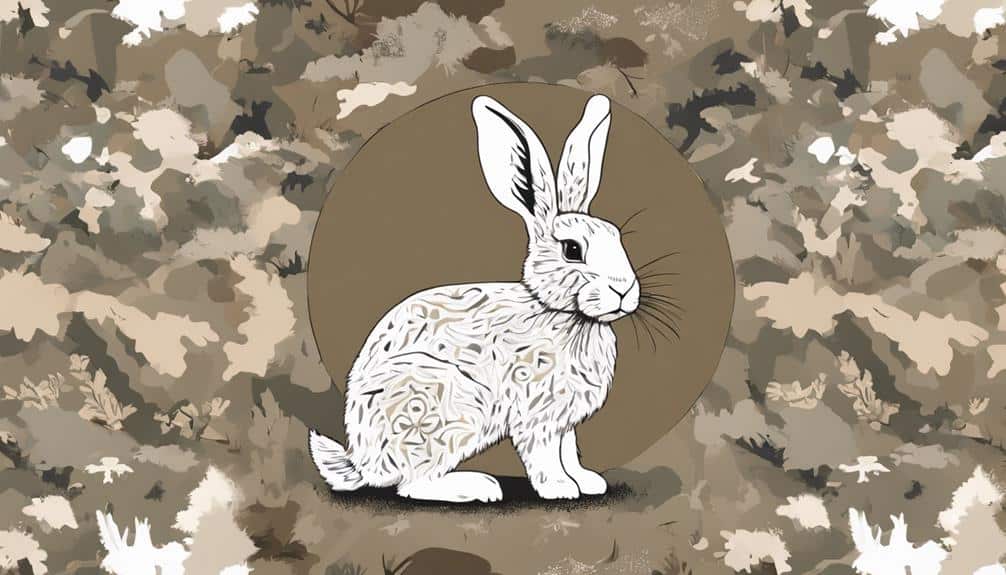
Distinct markings on fluffy bunny breeds serve important benefits beyond just aesthetic appeal, aiding in easy identification and genetic tracking. The colored coat patterns and unique eye circles found in various rabbit breeds play a vital role in distinguishing individual rabbits within a group or litter.
For breeders, these distinct markings are invaluable in tracking lineage and genetic traits, facilitating more effective breeding programs. In competitive show circuits, rabbits with eye-catching markings often capture the attention of judges, enhancing their chances of success due to their visual appeal.
Additionally, in the wild, unique markings can act as a form of camouflage, helping fluffy bunny breeds blend into their surroundings and evade predators more effectively. The diverse array of patterns and colors in these markings not only contribute to the beauty of fluffy bunny breeds but also serve practical functions that aid in their identification, genetic tracking, and survival in various environments.
Frequently Asked Questions
What Are the Really Fluffy Bunnies Called?
Fluffy bunny breeds, like Angoras, are known for their dense, luxurious fur. Regular grooming is key to maintaining their fluffy coat. Consider English or French Angoras for adoption if you seek an elegant, plush rabbit companion.
What Is the Rarest Breed of Rabbit in the World?
The rarest breed of rabbit in the world is the Columbia Basin Pygmy Rabbit. Conservation efforts aim to save this endangered species through breeding programs, habitat restoration, and predator control to combat population decline and low genetic diversity.
What Are the Distinguishing Features of Rabbit?
When observing rabbits, note their fur patterns, ear shapes, and eye colors. These distinguishing features contribute to their unique appearance. Fur patterns vary from solid to spotted, ear shapes range from lop to upright, and eye colors can include brown, blue, or red.
What Is the Rarest Bunny Fur Color?
Blue, the rarest bunny fur color, is caused by a dilution gene affecting eumelanin production. Found in breeds like Netherland Dwarfs and Mini Lops, these hues vary from soft powder to deep steel blue, prized by enthusiasts for their rarity and beauty.
Do Unique Markings on Fluffy Bunny Breeds Affect Their Ability to Get Along with Cats?
Certain bunny breeds and cats can coexist peacefully despite the fluffy bunny’s unique markings. It ultimately depends on the individual animals’ personalities and their upbringing. Some bunnies and cats may form a bond, while others may have a more challenging relationship. It varies from case to case.
Conclusion
You may argue that the unique markings on fluffy bunny breeds are simply a result of random genetic mutations. However, the intricate patterns and colors seen in these breeds aren't just a coincidence. Through careful breeding practices and environmental factors, these distinctive features have evolved to serve a purpose.
The visual diversity in fluffy bunny breeds reflects a combination of genetic, environmental, and cultural influences, making each bunny breed a truly unique and fascinating creature.


